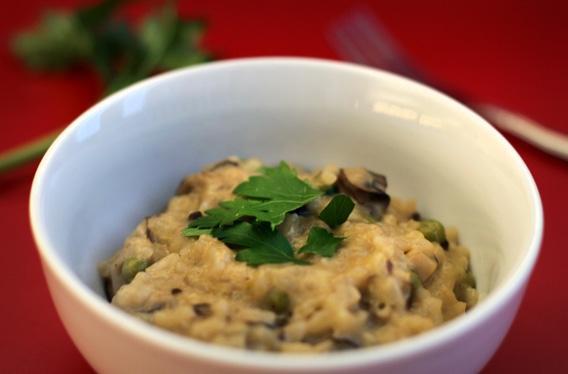For the longest time, I loathed making risotto. It wasn’t that I found it difficult—stirring, the primary activity required by risotto recipes, is not exactly rocket science. It was that the rice seemed to take so long to get tender, if it ever got tender at all. No matter how much stock I added, and no matter how long I stirred and simmered the rice, I always seemed to end up with hard, chalky grains that stuck between the cusps of my teeth.
Reader, I was doing it wrong. My mistakes were twofold. The first, and most important, was setting the heat too high. Making risotto requires sautéing arborio rice in butter or oil—with onions or shallots and sometimes other vegetables—and then gradually stirring in stock, waiting for each addition to be absorbed into the rice before adding the next. This slow, deliberate process simultaneously suffuses the rice with flavor and coaxes the starch out of it, giving the dish its signature creaminess. But if the heat’s too high, the liquid will evaporate instead of being sopped up by the rice, stymieing your efforts to get dinner on the table in a reasonable amount of time.
Instead, keep the heat somewhere between medium-low and medium—just high enough so the stock bubbles gently when you’re not stirring. Also, before you start, take note of the expiration date on your rice package—older rice tender to be drier and consequently takes longer to become tender.
My second mistake was expecting the rice to turn out perfectly soft. Risotto should be al dente, like pasta, with each grain offering a little resistance to your teeth. It is not some sort of savory rice pudding, mushy and fatty. And in the interest of avoiding the pudding zone, I prefer to keep the dairy content of my risotto in check, using olive oil instead of butter and not going completely overboard with high-fat cheese. You must add at least some Parmesan, but you should balance it out with soft, relatively lean goat cheese, which makes risotto silky and tangy rather than sticky and overly rich.
Because the splash-and-stir technique required for risotto doesn’t line up exactly with most conventional cooking techniques, it can be tricky to decide what vegetables to add to it, and when. Mushrooms are a no-brainer because they’re the Jimmy Buffett of the produce aisle, superbly laid-back. You can simmer them with rice for five minutes or two hours, and their texture won’t suffer one bit. Peas are another good risotto add-in, for the opposite reason: They take only a few minutes to cook through, so you can just throw them into the pot once the rice is already done.
You can of course skip these additions and keep risotto simple—to use as a pillow for pork tenderloin, perhaps—but you must not neglect one final addition: lemon. It’s well established that lemon is a universally useful seasoning, but nowhere is it more useful than in risotto, where it singlehandedly keeps wonderfully rich risotto from becoming excessively heavy.
Mushroom and Pea Risotto
Yield: 6 servings
Time: About 1 hour
6 cups vegetable, chicken, or mushroom stock
6 tablespoons extra-virgin olive oil
2 large shallots, chopped
12 ounces fresh mushrooms, preferably a mixture, trimmed and thinly sliced
Salt and black pepper
1½ cups arborio rice
½ cup dry white wine
1 cup fresh or frozen peas
4 ounces goat cheese
½ cup grated Parmesan cheese
½ cup chopped fresh parsley, plus more for garnish
Zest and juice of ½ lemon
1. Put the stock in a medium pot over low heat. Meanwhile, put 4 tablespoons (¼ cup) of the olive oil in a large pot over medium heat. When it’s hot, add the shallots and cook, stirring occasionally, until they begin to soften, about 5 minutes. Add the mushrooms and season with salt and pepper. Cook, stirring occasionally, until all the mushrooms’ liquid has evaporated, 8 to 10 minutes.
2. Add the rice and stir until it dries out and begins to stick together, about 5 minutes. Add the wine and cook, stirring once or twice, until it’s mostly absorbed into the rice. Begin adding the warm stock, about ½ cup at a time, waiting until each addition is mostly absorbed into the rice before adding the next. Stir frequently, and adjust the heat so the liquid simmers gently.
3. When the rice is plump and tender, after about 30 minutes of adding the stock, add the peas along with an additional 1 cup stock or water and cook, stirring frequently, until they’re tender, 7 to 10 minutes. Turn the heat to low and stir in the goat cheese and Parmesan cheese. Turn off the heat and stir in the remaining 2 tablespoons olive oil, the parsley, and the lemon zest and juice. Taste and adjust the seasoning, and serve hot, garnished with additional parsley. (Store leftover risotto in an airtight container in the refrigerator for up to a few days.)
Previously in You’re Doing It Wrong:
Pork Tenderloin
Olives
Tomato Sauce
Pesto
Lasagna
Frittata
Pizza
